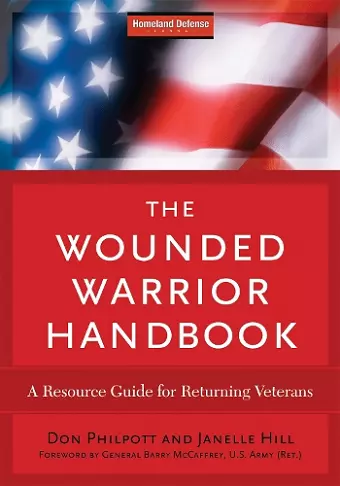The Wounded Warrior Handbook
A Resource Guide for Returning Veterans
Don Philpott author Janelle Hill author
Format:Paperback
Publisher:Government Institutes
Published:16th Jan '09
Currently unavailable, and unfortunately no date known when it will be back

The typical wounded soldier must complete and file 22 forms following an active-duty injury. To many soldiers and their families coping with the shock and reality of the injuries, figuring out what to do next—even completing tasks as seemingly easy as submitting paperwork—can be overwhelming and confusing.
Written with these men and women in mind, The Wounded Warrior Handbook provides our wounded heroes and their families with quick, straightforward answers to the questions they suddenly face and guides them through the deluge of processes, procedures, and policies they must adhere to in order to receive the care they deserve and need.
Comprehensive and easy-to-use, the Handbook compiles information regarding medical treatment, rehabilitation, counseling, support, and transition, including
Symptoms, treatment options, and information resources of common injuriesPrograms to help families reach and care for their injured soldiersDefinitions of the seven classifications of "casualty" and the notification process for next of kinDocuments family members should carry when traveling to see their loved onesChallenges of reintegrating into everyday life, and tips and resources for succeedingGuidance for finding a job that matches an injured soldier's physical abilities and skillsOrganizations offering advocacy and legal assistanceLocations of Veterans Affairs hospitals, medical centers, and clinics
Whether you work with members of the military or support a community that does, you can help our embattled men and women make the transition from active duty to post-war domestic life with this time-saving and life-restoring book.
Philpott and Hill offer straightforward answers to questions commonly asked by wounded U.S. military veterans and their family members as they struggle with the complexities of receiving their needed care. As the authors reveal, over 25,000 service members have sustained injury in the war in Iraq, and approximately half of these injuries have been serious enough to require medical evacuation back to the United States. Well organized, comprehensive, and relatively easy to follow, the material covers, e.g., obtaining medical treatment and post-treatment rehabilitation, setting up mental-health counseling, family support, and the difficult transition from wounded soldier to citizen veteran. The authors also explain filing for support from agencies like the Veterans Administration (VA) and the Department of Defense. The extensive listing of web sites and other contact information for veteran support agencies is alone worth the price of this valuable resource. Essential for all helping professionals who work with veterans and their family members, this belongs in all VA hospitals and clinics. Highly recommended for university libraries supporting the helping professions and larger public libraries * Library Journal, Starred Review *
The Wounded Warrior Handbook brings together information concerning medical treatment; rehabilitation; counseling; support; transition; and financial, legal, and tax matters. This handbook is a good purchase for academic libraries and is particularly recommended for public libraries. * Booklist *
This Handbook first addresses the recovery process, from the traumatic injury event onward, for the active serviceman or woman. It gives practical advice on everything from spotting the symptoms of depression to travel instructions for visiting family. It explains the terms of separation from military service and the process for determining and appealing the so-important physical disability status. . . . One useful chapter includes a discussion of financial, legal, and tax issues faced by active and discharged troops. Finally, a chapter on bereavement covers everything from grief support to burial expenses, military funerals, and death benefits. . . . Readers will discover that, despite recent scandals in VA hospitals and the common perception that the US does not support its wounded veterans and their loved ones, assistance in every conceivable aspect of transition and reintegration is available. And throughout, Philpott and Hill offer names, addresses, phone numbers, and Web addresses. * Foreword Reviews *
It contains a wealth of data that is and will be helpful on a continuing basis for different segments of our population. . . . It's pertinent information for those seeking specific kinds of post deployment/combat assistance, be it physical, mental, emotional or spiritual. . . . The Wounded Warrior Handbook does an excellent job of making clear what can benefit those who have served our country. * The Standard Times *
Philpott and Hill have compiled an invaluable list of things that vets, their families, other loved ones, friends and even private citizens can do to help vets return to society. * Veterans For Peace *
Offers a well-organized checklist of dos and don'ts for veterans, their families and friends and for others who want to understand their problems and challenges and to help them. The value of this book extends beyond health and injury related issues to broader aspects of reintegrating into civilian life. * Gazette *
This item will be of interest to veterans and those who live with or serve them, and is suitable for the reference or circulating collections of public, academic, and hospital libraries, along with VFW halls and medical professionals dealing with this type of patient. * American Reference Books Annual *
- Winner of ForeWord Book of the Year Finalist 2009.
ISBN: 9781605902715
Dimensions: 257mm x 181mm x 20mm
Weight: 685g
304 pages